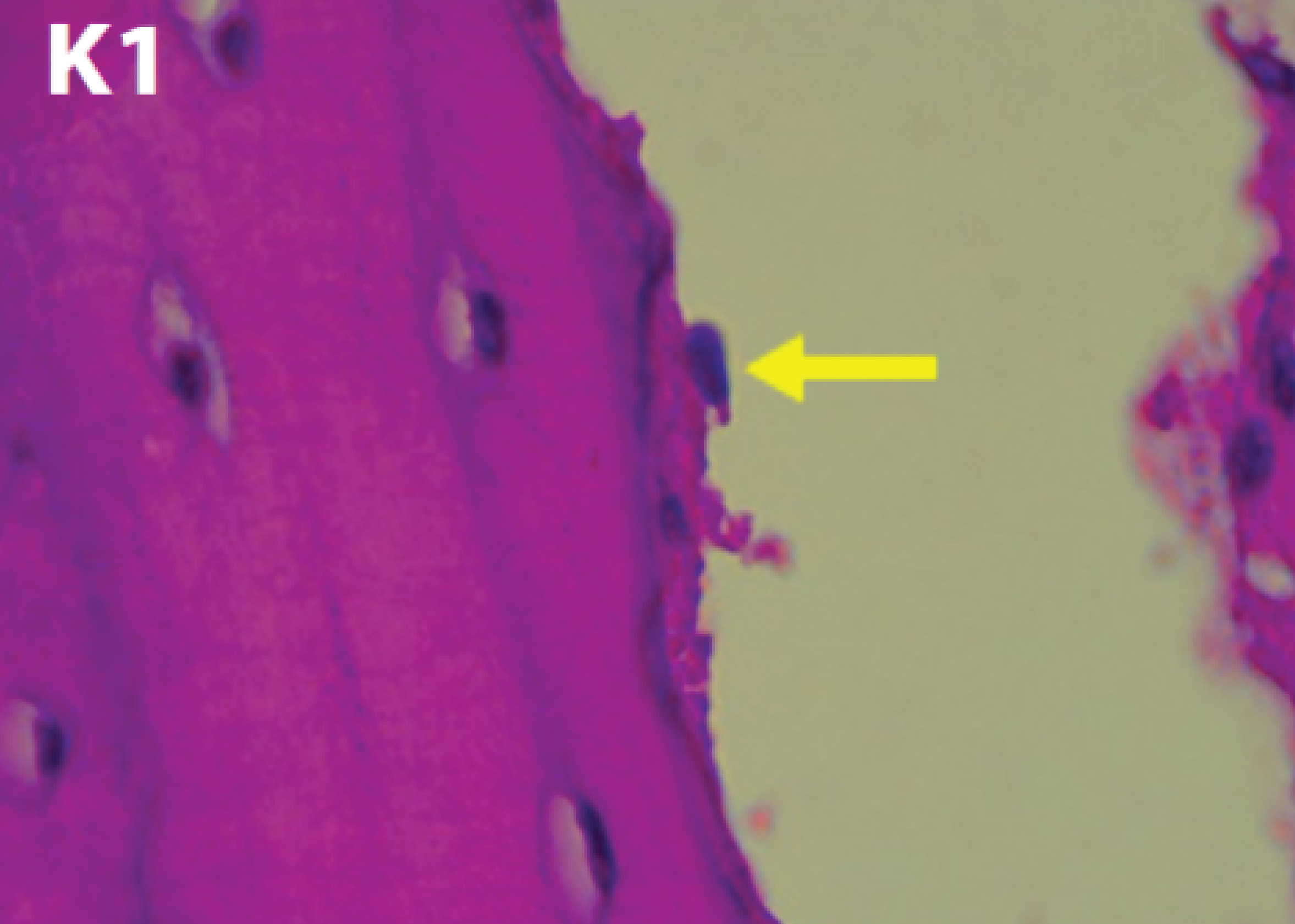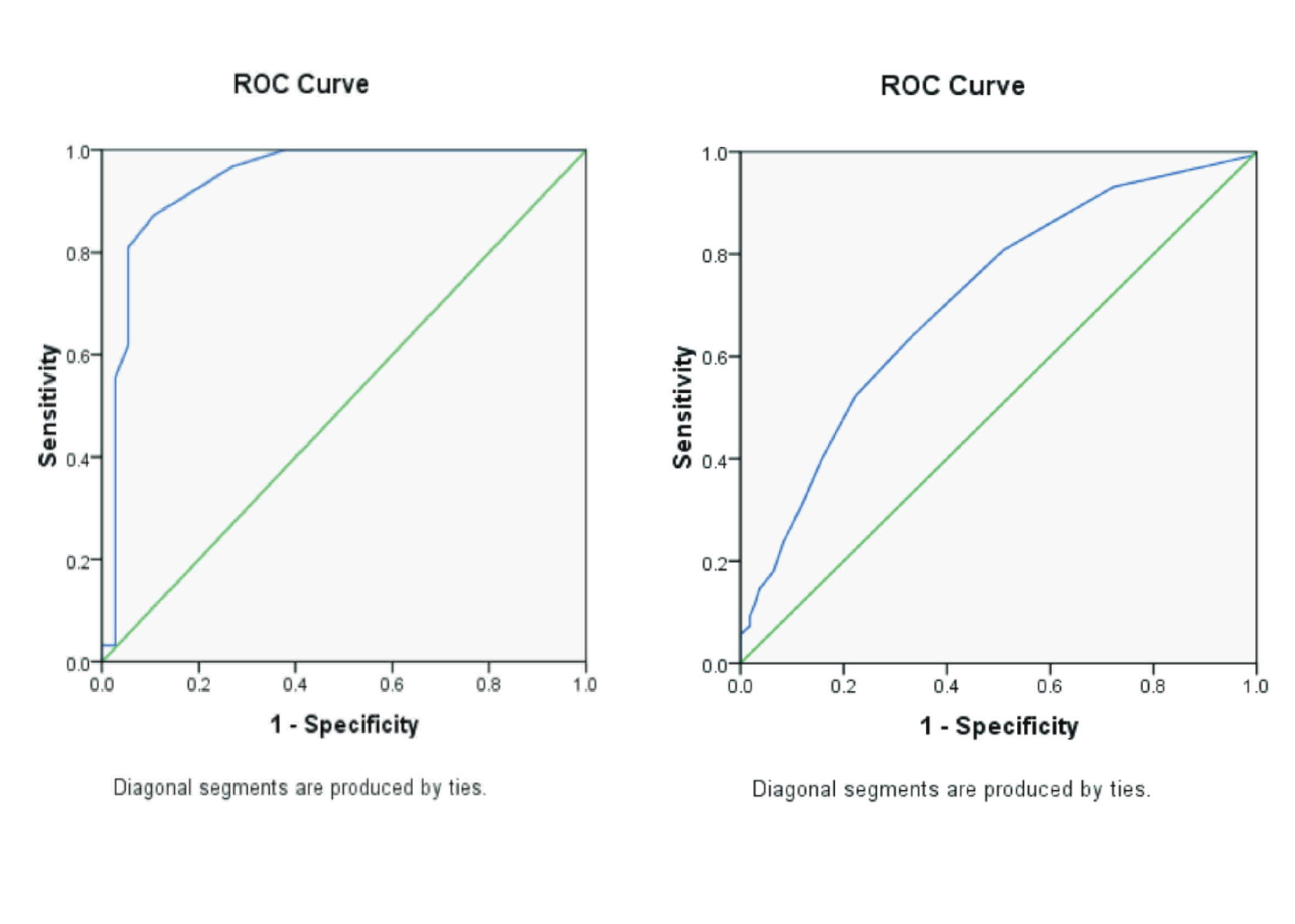DIFFERENCES IN OSTEOBLAST COUNT AND ITS EFFECT ON ORTHODONTIC MOVEMENT OF DIABETIC MODELS' TEETH AFTER ORAL ADMINISTRATION OF OLIVE OIL

Downloads
Background: In patients with uncontrolled diabetes, an increase in Advanced glycation end products (AGEs) inhibits osteoblast differentiation so that the number of osteoblasts decreases and interferes with bone formation in orthodontic movement. Giving natural ingredients such as olive oil is proven to increase the number of osteoblasts. Purpose: To determine differences in the number of osteoblasts and their effect on the orthodontic movement of diabetic teeth after oral administration of olive oil. Method: 25 male guinea pigs divided into four groups: diabetic guinea pigs treated with olive oil at a dose of 0.7; 1.05; 1.4 ml/day, distilled water, and healthy guinea pigs were given aquadest. Alveolar bone tissue samples were taken on the 15th day after orthodontic application, and then the number of osteoblasts was calculated histologically. Result: In the diabetic model group treated with olive oil doses of 0.7; 1.05; 1.4 ml/day, distilled water, and healthy guinea pigs given aquades were 2.900 ± 0.678; 4.320 ± 0.497; 5.920 ± 0. 460; 0.200 ± 0.200; 1.320 ± 0.415. The study showed that the olive oil treatment group had more osteoblasts than the untreated group. Analysis one way ANOVA showed a very significant difference between the treatment group and the untreated group (p≤0.01), while the LSD test showed a significant difference between groups. The highest number of osteoblasts was found at a dose of 1.4 ml/day. Conclusion: There was an increase in osteoblasts in the orthodontic movement of diabetic teeth after oral administration of olive oil.
Al-Hamdany, A.K., Al-Khatib, A.R., Al-Sadi, H.I., 2017. Influence of Olive Oil On Alveolar Bone Response during Orthodontic Retention Period: Rabbit Model Study. Acta Odontol. Scand. Vol. 75(6), Pp. 413-422.
Amin, M.N., Permatasari, N., 2016. Aspek Biologis Pergerakan Gigi secara Ortodonsi. STOMATOGNATIC - J. Kedokt. Gigi Vol. 13(1), Pp. 22-27.
Anggreni, D.P., 2020. Efektivitas Ekstrak Alga Hijau (Ulva lactuca) terhadap Penyembuhan Luka. Universitas Hasanuddin.
Brahmanta, M.F.W.A., Raharjo, P., 2018. Perbedaan Jumlah Osteosit antara Daerah Tekanan dan Tarikan pada Proses Pergerakan Gigi Akibat Pemberian Terapi Oksigen Hiperbarik. Dent. J. Maj. Kedokt. Gigi Vol. 12(1), Pp. 34-43.
Budirahardjo, R., 2015. Sisik Ikan sebagai Bahan yang Berpotensi Mempercepat Proses Penyembuhan Jaringan Lunak Rongga Mulut, Regenerasi Dentin Tulang Alveolar. STOMATOGNATIC - J. Kedokt. Gigi Vol. 7(2), Pp. 136-140.
Clemons, D.J., Seeman, J.L., 2018. The Laboratory Guinea Pig, 2nd ed. Taylor & Francis.
Costantini, S., Conte, C., 2019. Bone Health in Diabetes and Prediabetes. World J. Diabetes Vol. 10(8), Pp. 421-445.
Daher, C.P.S.A.G., Vianna, B., Carvalho, F. de, 2017. The Impact of Type 2 Diabetes on Bone Metabolism. Diabetol. Metab. Syndr. Vol. 9(85), Pp. 1-7.
Dhenain, T., Cote, F., Coman, T., 2019. Serotonin and Orthodontic Tooth Movement. Biochimie Vol. 161, Pp. 73-79.
Dwarakanath.V, B.J.G., Swamy, Chikka, C.K., 2015. Streptozotocin-A Diabetogenic Agent in Animal Models. Int. J. Pharm. Pharm. Res. Vol. 3(1), Pp. 253-269.
Eliades, T., 2019. The Ortho-Perio Patient; Clinical Evidence & Therapeutic Guidelines, 1 st. ed. Quintessence Pub Co, Batavia.
Epsilawati, L., 2018. Assessments of The Mandibular Cortical Bone Quality on Patient With Diabetes Mellitus Tipe II. J. Pengabdi. Kpd. Masy. Vol. 2(2), Pp 118-123.
Fatimatuzzahro, N., Ermawati, T., Prasetya, R.C., 2020. Efek Pemberian Gel Ekstrak Biji Kopi Robusta (Coffea canephora) terhadap Jumlah Osteoblas dan Osteoklas pada Tulang Alveolar Tikus Periodontitis. Padjadjaran J. Dent. Res. Students Vol. 4(2), Pp. 128-133.
Goulart, M.F.G.M. da G.V., Giannasi, L.C., Hiraoka, C.M., Melo, G. de F.S., Sousa, A.G.V. de, Nóbrega, C.J.P., Zangaro, R.A., Salgado, M.A.C., 2017. Effects of The Gaalas Diode Laser (780 Nm) on The Periodontal Tissues During Orthodontic Tooth Movement in Diabetes Rats: Histomorphological and Immunohistochemical Analysis. Lasers Med. Sci. Vol. 32(7), Pp. 1479-1487.
Handayani, B., Brahmanta, A., 2018. Jumlah Osteoblas [ada Daerah Tarikan dengan Pemberian Ekstrak Propolis sebagai Pencegahan Relaps Orthodonti. Dent. J. Maj. Kedokt. Gigi Vol. 12 (1), Pp. 28-33.
Herniyati, H., 2016. Analisis Vegf pada Pergerakan Gigi Ortodonti Setelah Pemberian Seduhan Kopi Robusta (Coffea canephora). J. Teknosains Vol. 5(2), Pp. 90-96.
Herniyati, H., Narmada, I.B., Soetjipto, S., 2016. Effect of Robusta Coffee (Coffea canephora) Brewing on Levels of Rank and Tgf-Î’ in Orthodontic Tooth Movement. Dent. J. Maj. Kedokt. Gigi Vol. 49(3), Pp. 143-147.
Hikmah, N., 2015. Profil Osteoblas dan Osteoklas Tulang Alveolar pada Model Tikus Diabetes Tahap Awal dengan Aplikasi Gaya Ortodonti yang Berbeda. El-Hidayah J. Biol. Vol. 5 (2), Pp 97-102.
Munarsih, E., Imanda, Y.L., 2018. Uji Perbedaan Kadar Gula Darah Mencit Putih Jantan yang Diinduksi Aloksan Sebelum dan Sesudah Pemberian Minyak Zaitun Ekstra Virgin. J. Ilm. Bakti Farm. Vol. 3(2), Pp. 19-22.
Prasetya, C.A., 2017. Efek Konsumsi Kopi terhadap Pembentukan Lesi Aterosklerosis Koroner pada Model Tikus Periodontitis. Universitas Jember.
Santoso, S.D., Suryanto, I., 2017. Komparasi Efek Pemberian Minyak Jintan Hitam (Nigella sativa) dengan Minyak Zaitun (Olea eiropea) terhadap Penurunan Glukosa Darah pada Mencit (Mus Musculus) Strain Balb/C. J. Sain Heal. Vol. 1(1), Pp. 36-42.
Saputri, R.N., Herniyati, H., Prijatmoko, D., 2021. Efek Induksi Gaya Mekanis Ortodonti terhadap Perubahan Jumlah Sel Osteoblas Tulang Alveolar Gigi Tikus pada Daerah Tarikan. E-Journal Pustaka Kesehat. Vol. 9(2), Pp. 66-70.
Shita, A.D.P., 2017. Diabetes dan Pergerakan Gigi Secara Ortodonsi. Universitas Jember.
Suparwitri, S., Noviasari, P., 2019. Effect of Olive Oil Administration on The Level of Transforming Growth Factor Î’1 during Orthodontic Tooth Movement in Old and Young Guinea Pigs. F1000Research Vol. 29(8), Pp. 1-15.
Wijaya, S., Prameswari, N., T, M.L., 2015. Pengaruh Pemberian Gel Teripang Emas terhadap Jumlah Osteoklas di Daerah Tekanan pada Remodeling Tulang Pergerakan Gigi Ortodonti. J. Dent. Kedokt. Gigi Vol. 9(2), Pp 171–179.
Copyright (c) 2022 Journal of Vocational Health Studies

This work is licensed under a Creative Commons Attribution-NonCommercial-ShareAlike 4.0 International License.
- The authors agree to transfer the transfer copyright of the article to the Journal of Vocational Health Studies (JVHS) effective if and when the paper is accepted for publication.
- Legal formal aspect of journal publication accessibility refers to Creative Commons Attribution-NonCommercial-ShareAlike (CC BY-NC-SA), implies that publication can be used for non-commercial purposes in its original form.
- Every publications (printed/electronic) are open access for educational purposes, research, and library. Other that the aims mentioned above, editorial board is not responsible for copyright violation.
Journal of Vocational Health Studies is licensed under a Creative Commons Attribution-NonCommercial-ShareAlike 4.0 International License














































